People
‘In the Studio, You Have Your Own Folklore’: Artist Edgar Sarin on the Stories Artists Tell Themselves
Sarin is currently showing work at two venues in Paris.
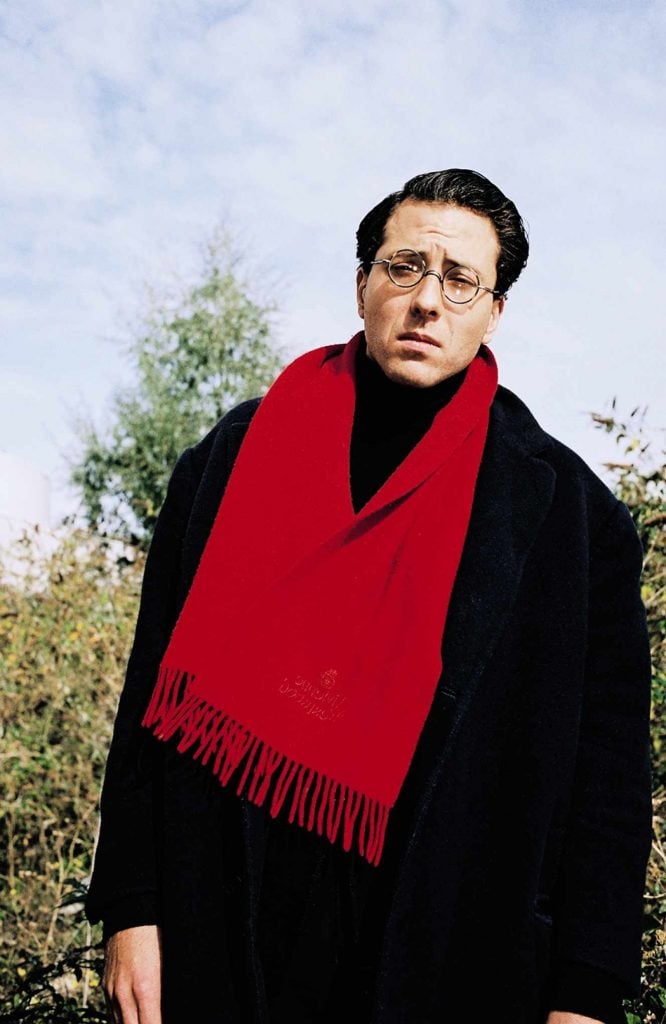
Sarin is currently showing work at two venues in Paris.

Pac Pobric

The first time I saw the French artist Edgar Sarin’s work was at the Cutlog art fair in New York in 2014. His gallery at the time, L’Inlassable, was showing paintings wrapped in archival paper that were to be opened only after predetermined periods of time. One picture was meant to be unveiled only after the artist’s death. I found the mystique appealing at the time, but by 2017, when Sarin had a solo show at Konrad Fischer in Berlin, he had changed tack.
Now he was a performer. Before the show, he buried a group of his artworks inside crates in the Grunewald forest in West Berlin and spent the morning of the opening unearthing them and dragging them back to the gallery for installation. A photographer followed him throughout the streets to document the event.
Sarin doesn’t do either of these kinds of things anymore. “I am against performance,” he told Artnet News earlier this month. Nor is he obscuring his work. The paintings on view at his Michel Rein show, “Victoires (Suite),” are on full display. These days, his concerns are twofold. First, he is interested in circumstance, meaning that he seeks, as much as possible, to craft each of his exhibitions in accordance with the material, cultural, and environmental facts of the place he’s in.
Secondly, he is determined to pursue his own individual intuitions (a term he uses quite often), saying that he wants to make art “from the gut,” as he puts it, and without preceding recourse through ideas or theories.
We spoke with Sarin on the occasion of three recent exhibitions, about why artists should not simply put their works on display, his interest in vernacular architecture, and why he believes painters shouldn’t spend too much time with ideas.
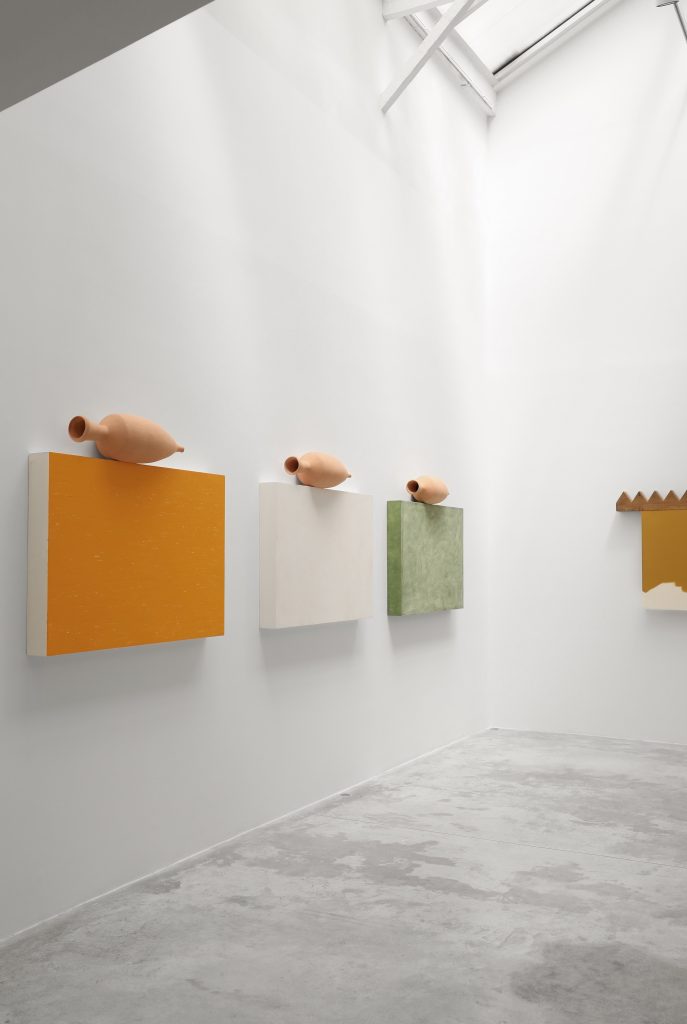
“Victoires (Suite),” Edgar Sarin’s show at Galerie Michel Rein in Paris in 2021. Photo: La Méditerranée.
I know you have a very specific way of approaching your exhibitions. What can you tell us about that?
The first move I do when it comes to making a new show is getting a glimpse at the environment. It makes absolutely no sense to build a protocol or conceptual gesture before you do that, or to put something on display and let it be—especially currently, amid the environmental crises we’re dealing with. So I visit the gallery and try to understand the culture of the place to figure out what we can use from the area to build something.
I also believe that, in a period of great disorientation, we have to look at what ancient people did. But we can’t do things the same way. The works made in egg tempera in my Michel Rein show in Paris were taken from an industrial egg factory. They come from the supermarket. I find it very touching to picture a little society trying to do something like Giotto, but with eggs taken from a manufacturing plant.
But “Objectif: Société,” the show you just closed at the Centre d’art Albert Chanot in Clamart, was put together very differently.
Yes. The world points in the right direction, and I believe the role of our generation is to make a first gesture that is in compliance with the environment.
There is a monument in Clamart near the Centre d’art Albert Chanot, and when I visited the monument, I noticed there were trees that had fallen down in a storm. The roots of the tree had come up, revealing a very fine clay. This clay is usually deep underground, and cannot be accessed so easily. Within the gallery, we spent months, 30 to 40 of us, building from 20 cubic meters of this clay two artworks, both inspired by vernacular architecture: One is like a chimney that goes very high up, and the other, which I call the Kaaba, is inspired by ancient Celtic granaries that were built above ground on pilotis to keep food cool and away from animals.
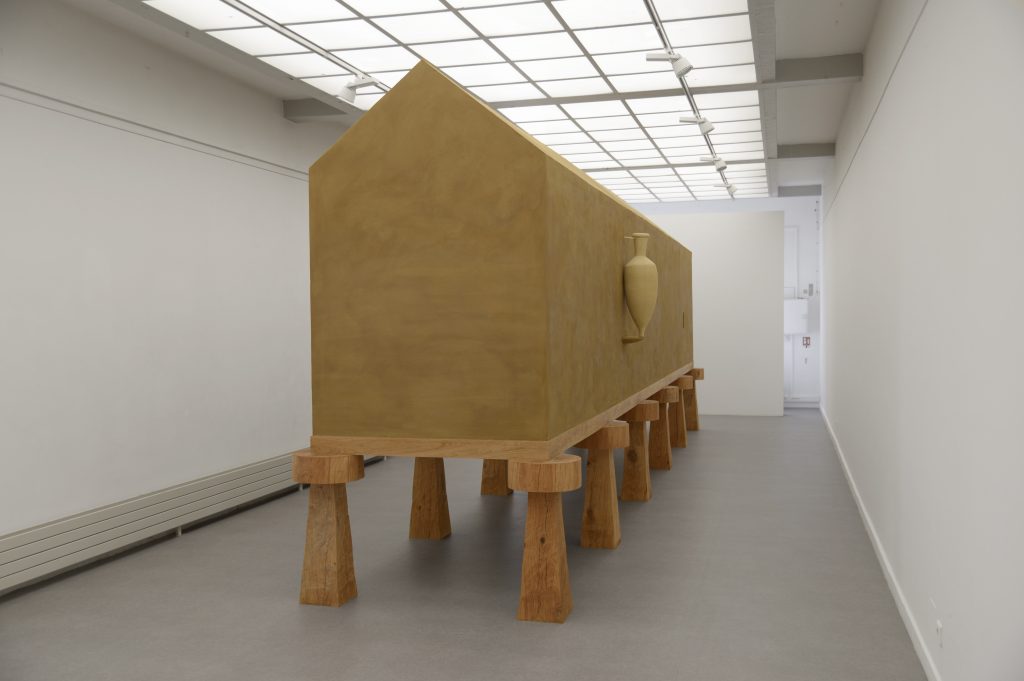
Edgar Sarin’s Kaaba (2020), which was on view at the Centre d’art contemporain Chanot in Clamart, was inspired by ancient Celtic granaries and the vernacular architecture of pre-Modern forms. Photo: La Méditerranée.
The idea with the Kaaba was to have the largest possible surface for it to receive artworks. At the beginning of the show, there was almost nothing on it. But we began to add paintings, a little bit as if you go to an old city in Italy or France and you see graffiti from 300 years ago. It’s this kind of thing I was looking for.
At the end, I harvested all these works from the Kaaba, put them in storage, and returned the unused clay to the forest. Now we can begin the process over and rebuilt somewhere else. It’s a harvesting structure. We plant the seeds, and I believe the Clamart show pulls together my research into what I call the heuristic of the exhibition, meaning the exhibition as a space of discovery. We don’t come with a theme or something to say. We say something and see how it unravels.
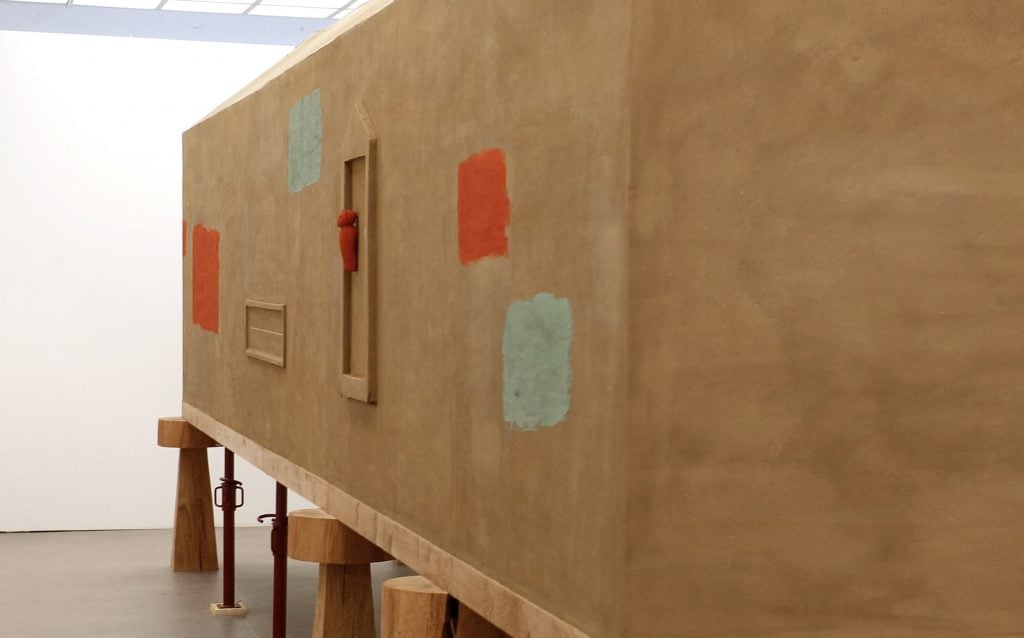
Throughout the course of “Objectif: Société,” Sarin returned to the Kaaba, painting images onto the work. At the end of the show, the Kaaba was deconstructed, the images were kept and moved into storage, and unused clay was returned to the forest. Photo: La Méditerranée.
So this project is very different from what you do in your studio.
Yes. In the practice of a living artist, I would say there are two phases.
First, there is the studio. It’s a place of intimacy, of loneliness. We enter each morning and never know how we’ll exit. In the studio, you have your own folklore.
The exhibition space is altogether different. It’s not a place to bring artworks from the studio. It’s more about preparing the space. The environmental constraints are altogether different. It’s public; there is a flow of people coming through. So I want to see what we can develop within this organism that we cannot achieve in the loneliness of the studio.
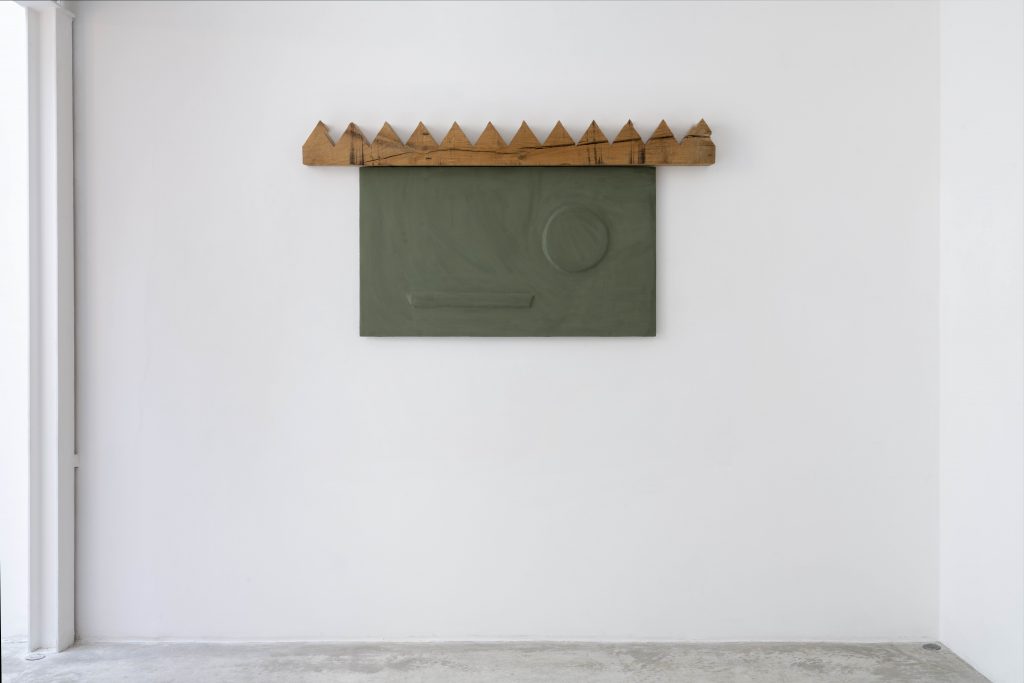
Edgar Sarin’s Les demoiselles d’Avignon (2020). When he works in his studio, Sain tries to dig deep into the “most naive” part of himself. Photo: La Méditerranée.
Let’s also talk about your project for the group show “Napoléon? Encore!” at the Dome of the Invalides, where Napoléon is buried in Paris. You built something there that’s similar to the Kaaba, and you literally took structural elements—the pilotis on which the Kaaba was built in Clamart—to build the new one. What was the idea there?
Napoléon, as you can imagine, is a very critical subject in France, especially when it comes to the looting of other civilizations. That’s why it was interesting to go to Clamart and steal four pilotis, in the purest Napoléonic tradition, bring them next to his tomb, and build a new Kaaba.
But when [“Napoléon? Encore!” curator] Éric de Chassey invited me to contribute to the show, I told him I didn’t want to make any kind of literal, or very discursive kind of institutional critique. When there’s a thematic exhibition, you have to support some discourse or some story, and it’s a very delicate position for an artist, I believe. The answer should come from the gut. I believe it’s very harmful for the work to be too thought out.
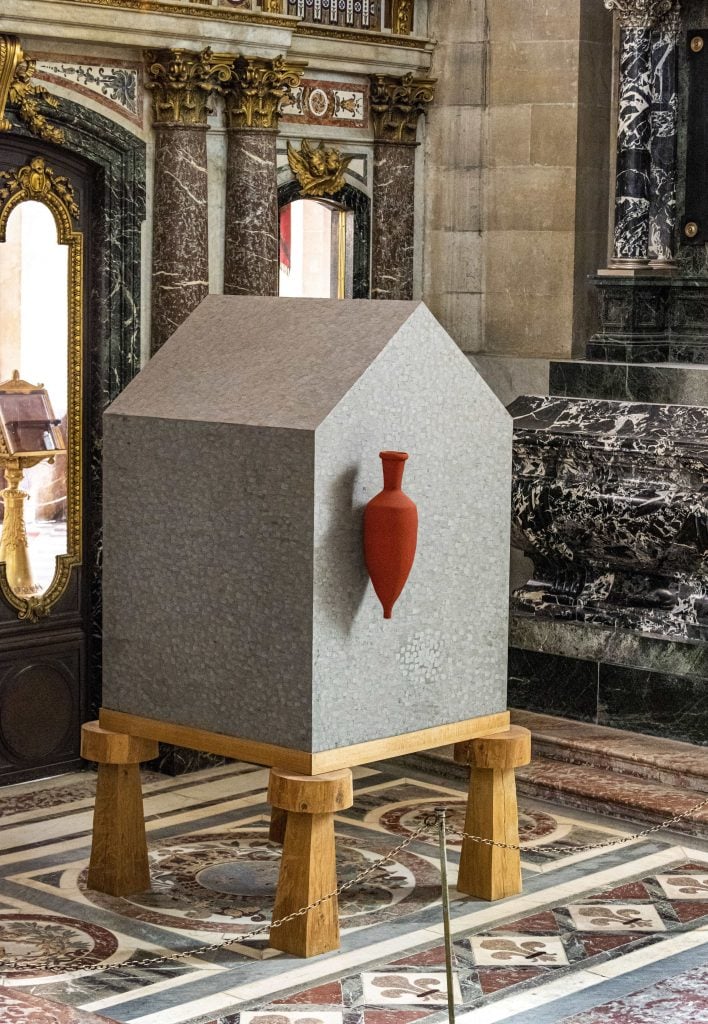
Edgar Sarin’s Kaaba for Napoléon (2021) in the exhibition “Napoléon? Encore!” at the Musée de l’armée in Paris was built using four pilotis taken from the Kaaba made for the Clarmart exhibition. Photo: La Méditerranée.
But it’s very obviously connected to bigger conversations about looting and cultural heritage in the art world and beyond, even if you don’t intend it.
Yes, it’s connected. But for me—let me take this example. Anselm Kiefer did some lectures at the Collège de France, and he said something very interesting in his opening talk. He said, more and more, art students read all they can and become the cleverest historians of Baudrillard or Walter Benjamin. From this, they conceptualize an artwork and realize it afterwards. And he says, ‘I do the exact opposite.’
That’s what I’m embodying as well. I’m in front of a canvas and there’s no intellectualization. I’m trying to reach the most naive part of myself. The move comes first, and the theory is after.